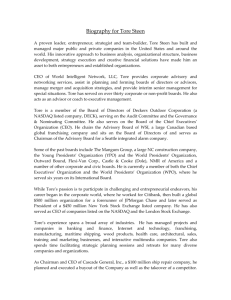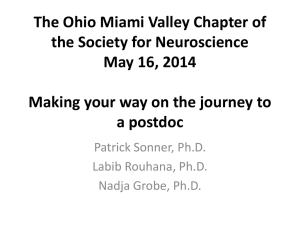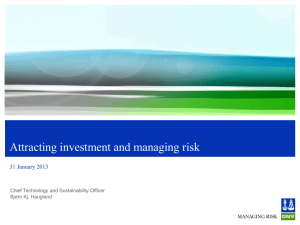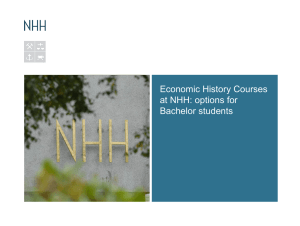Interview with Emmet Mc Cormack Background Emmet Mc Cormack
advertisement
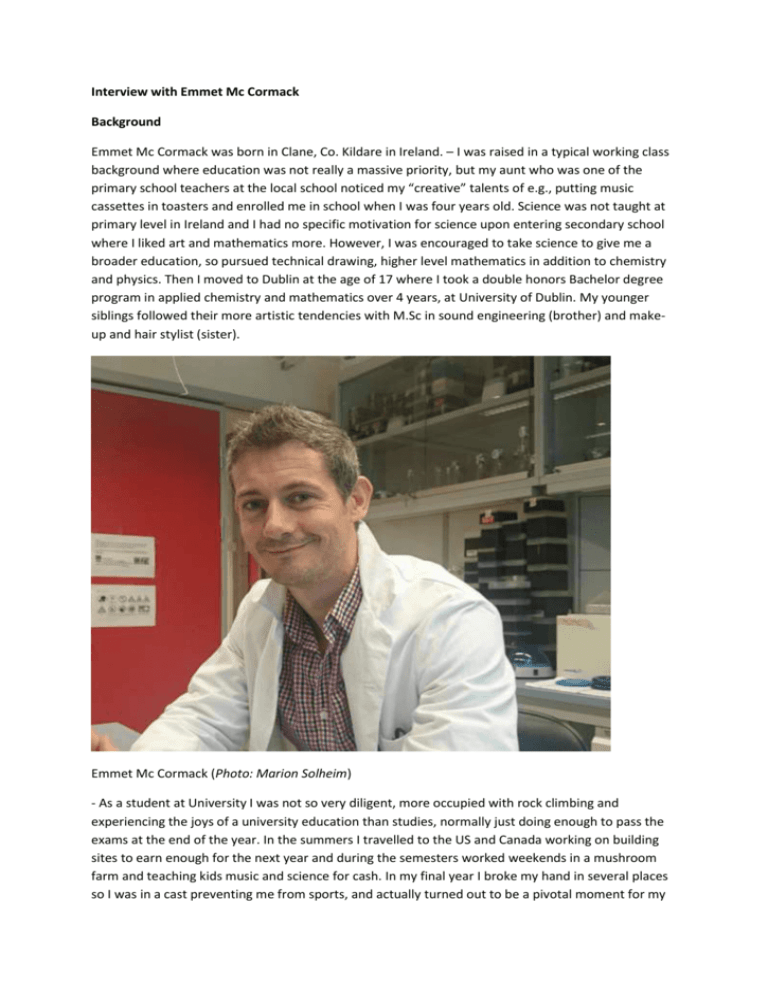
Interview with Emmet Mc Cormack Background Emmet Mc Cormack was born in Clane, Co. Kildare in Ireland. – I was raised in a typical working class background where education was not really a massive priority, but my aunt who was one of the primary school teachers at the local school noticed my “creative” talents of e.g., putting music cassettes in toasters and enrolled me in school when I was four years old. Science was not taught at primary level in Ireland and I had no specific motivation for science upon entering secondary school where I liked art and mathematics more. However, I was encouraged to take science to give me a broader education, so pursued technical drawing, higher level mathematics in addition to chemistry and physics. Then I moved to Dublin at the age of 17 where I took a double honors Bachelor degree program in applied chemistry and mathematics over 4 years, at University of Dublin. My younger siblings followed their more artistic tendencies with M.Sc in sound engineering (brother) and makeup and hair stylist (sister). Emmet Mc Cormack (Photo: Marion Solheim) - As a student at University I was not so very diligent, more occupied with rock climbing and experiencing the joys of a university education than studies, normally just doing enough to pass the exams at the end of the year. In the summers I travelled to the US and Canada working on building sites to earn enough for the next year and during the semesters worked weekends in a mushroom farm and teaching kids music and science for cash. In my final year I broke my hand in several places so I was in a cast preventing me from sports, and actually turned out to be a pivotal moment for my future. Finally with nothing to distract me I had to focus on my final year projects in Chemistry and Mathematics. In my chemistry project I was asked to investigate a particular reaction that one of the PhD students in the group was having issues with. I went to the library to dig out information and later I got free hands to play in the lab, which I found very exciting. Fortunately, I managed to solve the problem and realized that actually this science business was really fun. I got further encouragement by doing really well in my final exams and then one of my professors told me I should do a Ph.D. I suppose once someone plants that seed in your head, it’s very difficult to ignore. I had never really thought about postgrad studies, my main aim was to get a good degree and get a job, but I then decided that I’d give a Ph.D a go and see how that went. After four years of studies I finished my Ph.D in Pharmacy (Pharmacognosy/medicinal chemistry), with the Ph.D thesis entitled “Design, Synthesis and In Vitro Evaluation of Novel Anti-Cancer Compounds”, defended in February 2003. The move into the cancer field was a personal choice, a very close uncle had just developed cancer and my grandfather had previously survived colorectal cancer and I wanted to use my knowledge and skills in that direction. - What were your major challenges during your Ph.D studies? - Well, I was lucky in so far as I got a scholarship for Ph.D, because of my exam results, but at the time, you only got 5.000 Euro a year which was not enough to live on. Most of my friends had left Ireland and moved to Australia for a few years and were earning good money and living the good life, while I was still in student mode and living on the bread line. To make ends meet I demonstrated chemistry labs at Dublin Institute of Technology (similar to Bergen University College) and taught pharmaceutical chemistry. My project was also funded from industry by Jansen Pharmaceuticals (now Johnson and Johnson) which meant that we had tough deadlines to meet and the products had to be prepared to industrial standards. So there were many 16 hour days in the run up to deadlines which was tough when you had 2 part time jobs to fulfill in addition. So sometimes I looked at my friends and wondered if I had made the right decision. - Another challenge was some arising conflicts with my supervisor. What got me interested in chemistry in the first place was the exploratory nature and collaboration. While my supervisor needed to get us to produce compounds for the company and was paranoid about collaboration or that anyone would know what we were working on. 12 years later and I still have not published anything from my Ph.D which is very frustrating. Also, in those kinds of studies (very large molecule synthesis) you never get the final products until right at the end of your Ph.D time. Many times I felt that I had no progress and it can be difficult mentally, to put in so much work and not feel that it’s really paying off. But as we say in Ireland “If you throw muck at the wall, some of it will finally stick” or as my mentor during my Postdoc here in Bergen, Professor Bjørn Tore Gjertsen used to say: “When the going gets tough, the toughs get going” and you just have to keep on working and you´ll get there in the end…. (although I think Bjørn Tore stole that line from Billy Ocean ;-) I suppose a Ph.D is a bit like training for a sport, your never gonna get faster if you don’t push your boundaries. - My advice to the Norwegian Ph.D students is that you should not think of yourselves as employees but as students. You have 3-4 years to explore and develop as a scientist, so use that opportunity to immerse yourself in your discipline and not treat it like a 9-5 job. It’s a very short period of time and no matter how tough, time will fly and you will miss this time as a Ph.D when it’s over. - After finishing my Ph.D dissertation, waiting for the Ph.D defense, I did a short postdoc period to make all the compounds I previously had designed and produced in experimental scale, in bulk, Emmet says. - How did you end up here in Bergen? - I met a Norwegian girl in the final year of my Ph.D and came here in April 2003. Professor Bjørn Tore Gjertsen had a postdoc position in acute leukemia which I applied for. Although, this was not chemistry, and I did not get the position, Bjørn Tore offered me the possibility to learn more biology of cancer and offered me a six months contract to see how I could get on. - It was a bit of shock to the system, in both the working environment and biology. During my Ph.D studies I had taken an animal course to extract a protein critical to dividing cancer cells from pig brains. When Bjørn Tore learned of this he asked me to develop an animal model of acute myeloid leukemia. Also, Bjørn Tore had funding for an optical imaging system, and I was asked to develop that for preclinical imaging of cancer. It was a lot of work in a field I was completely unfamiliar with, but I guess again, through a lot of perseverance we managed to make one animal model and imaging modality, which now today extends to over 40 different models and multiple imaging modalities and probes. - Currently, I’m a full Professor in Pharmaceutics and Pharmaceutical Technology (“Galenisk Farmasi” in Norwegian) and have developed my own research group (organized within the section of Haematology and the translational haematology cluster or THC) at Department of Clinical Science K2 at UoB. My group currently consists of 1 Veterinarian, 2 Postdocs, 3 Ph.D Students, 1 research associate in Chemistry, 1 M.Sc student, 3 technicians and 4 PhD students that I co-supervise. I have graduated three PhD students (Elisabeth Silden, Maja Mujic and Øystein Helland) and 14 Master students (9 A´s, 4 B´s and 1 C) so far. - Our current main focus is translational molecular imaging in cancer. We have a lot of collaboration with postdoc Spiros Kotopoulis in Professor Odd Helge Gilja’s group and with Professor Bjørn Tore Gjertsen, besides international cooperation with groups in Sweden, Switzerland, USA, Ireland and Norway. Our main goals can be summarized as to develop relevant preclinical models for development of drugs and imaging agents. We develop patient xenograft models or “Avatars” of patient’s disease and complimentary or theranostic imaging. Many drugs fail in clinical trials and we believe this is, in part, through use of inappropriate models and lack of imaging strategies. So our aim is to try and use the most relevant models and imaging strategies for the disease in questions to truly interrogate the drugs’ potential. - In our department Professor Øystein Bruserud, Professor Bjørn Tore Gjertsen and I work very close, where I contribute with the preclinical in vivo part. We are small here in Bergen so we have to work together. Øystein, who recently got a big project from the Norwegian cancer Society, is a specialist in patient biobanks, immunology, metabolism and he has a vast clinical experience. Bjørn Tore’s expertise in molecular biology and clinical trials makes him an expert in development of new therapeutic strategies. - Bjørn Tore has been really a great mentor, Emmet says. - And you are also involved in the company KinN Therapeutics? - Yes, KinN Thearpeutics AS was founded by Stein Ove Døskeland and members of his group in addition to Bjørn Tore Gjertsen in 2004, based on a cyclic AMP inhibitor patent, but it became a sleeping activity after a while. Later, during my postdoc with Bjørn Tore, industry became interested in our activities and they wanted to collaborate. We tried this initially, but there is always some friction in this arrangement as industry just wants the results and are maybe not so interested in publications, whereas in academia it’s a case of publish or perish. Nearing the end of my postdoc period Prof. Jim Lorens, who at the time headed Unifob’s interests at the Department of Biomedicine, was interested in setting up a program, whereby industry could gain access to the exciting things going on in academic labs through a contract research group. As Bjørn Tore and I had already had interactions with academia, and my funding was running out, the idea was to give me an opportunity to try and develop this as a business idea with Unifob as a facilitator – while giving something back to Bjørn Tore’s lab for access to the technology. We started activities in May of 2007 I think, and by the end of the year we had two employees and made a good profit for Unifob. At that point the decision was made that this should be spun out into a company, so Bjørn Tore and I bought all the shares in KinN Therapeutics AS and paid Unifob for transfer the activities there. It was a difficult transition, with conflict and intrigue along the way. But you live and you learn ;-) - The concept with KinN Therapeutics so far has been a little different than a conventional company that is mostly just interested in earning profit. Our goal was to secure people and to have a model whereby we could interact with the pharmaceutical sector and gain access to novel cancer drugs, without compromising academic integrity. Any profit earned goes back into the company and its employees; shareholders do not earn a penny. This has worked reasonably well, and we have been able to retain students as they move from M.Sc to Ph.D or Ph.D to Postdoc through activities within the company, that otherwise would have had to leave academia to get a job. Through KinN we provide students an alternative research career option to just academia and their contributions to the academic environment through collaboration are priceless. A good example is veterinarian Mihaela Popa who has helped establish many preclinical models for the groups at MOFA, which would never have been possible without KinN. KinN also uses the core facilities here at UoB, and is an access point for big grant applications e.g. Horizon 2020. On the whole KinN has really contributed to the local academic environment. -Finally, what are your future plans? - I want to continue with pharmacy, because we want to further develop the galenic approach in making new pharmaceuticals. We have identified some compounds and we want to develop promising drugs, which eventually can foster new companies. - In this area MedViz plays a key role in financing research and in network building, Emmet concludes, before he quickly is off for the next meeting, a true working class hero.
